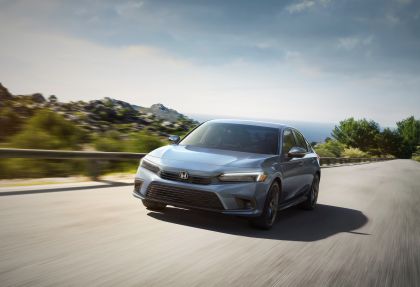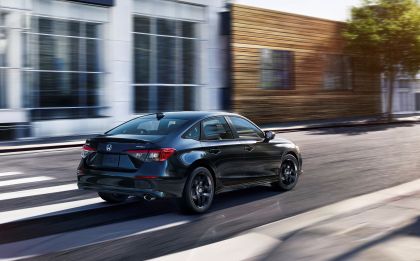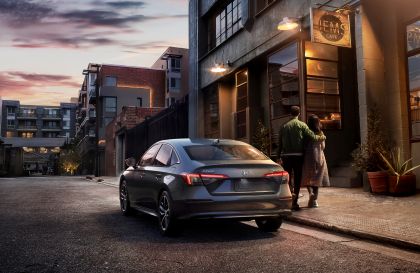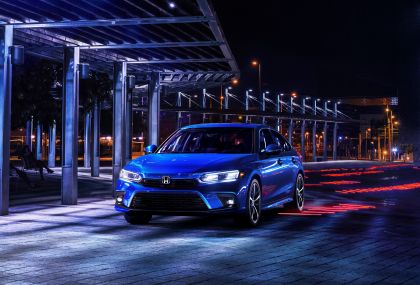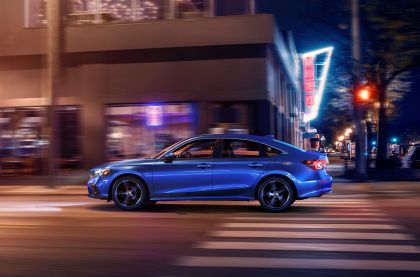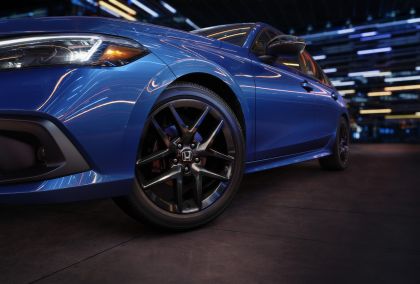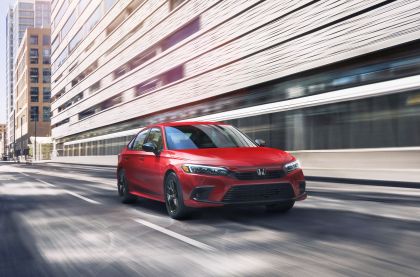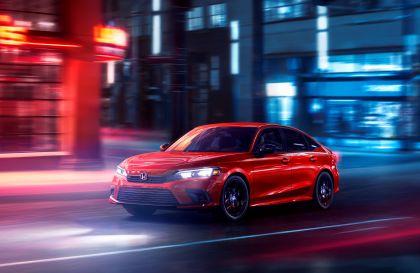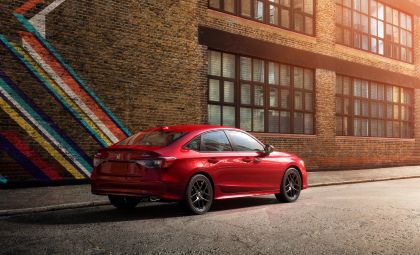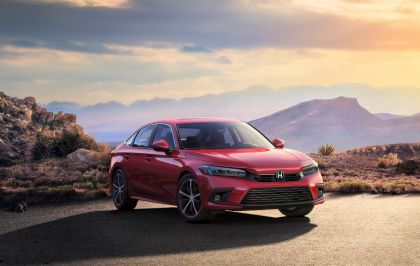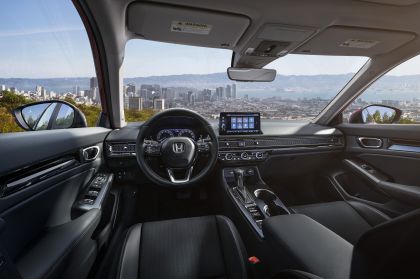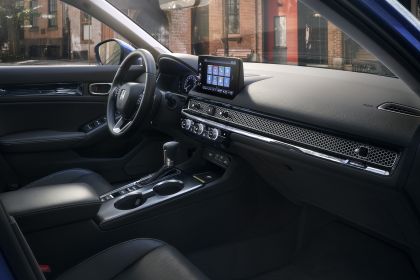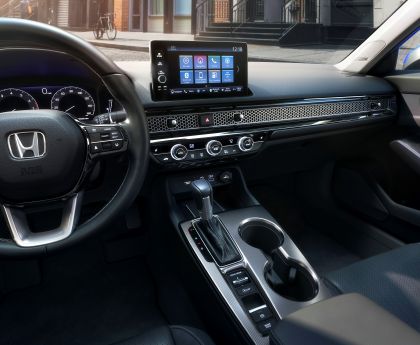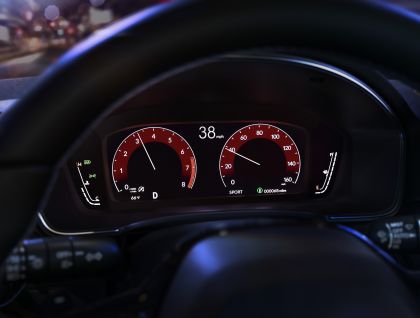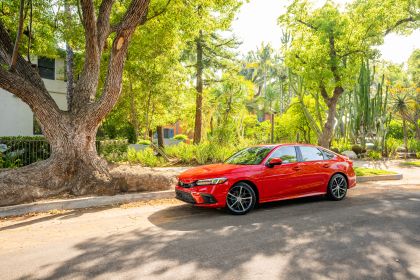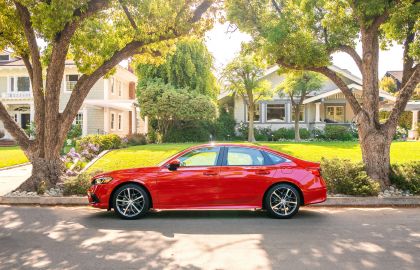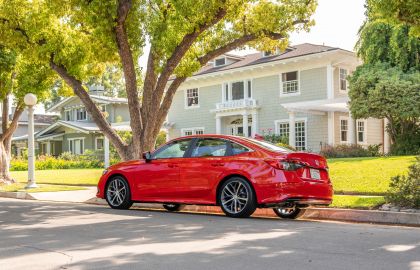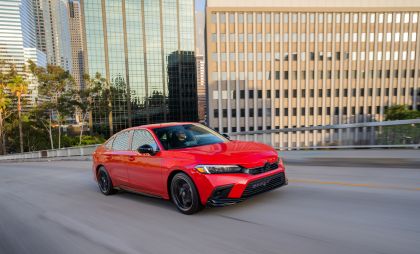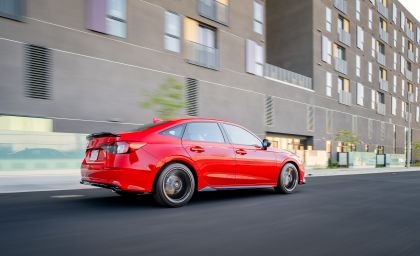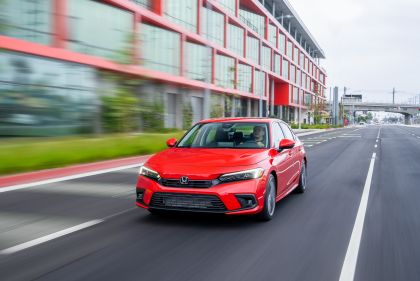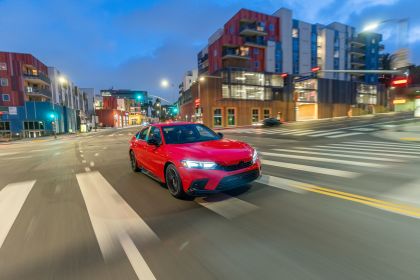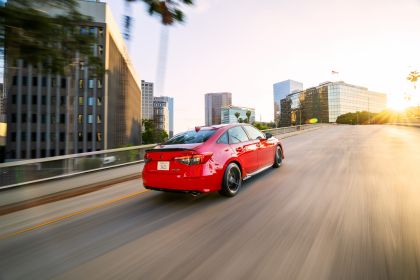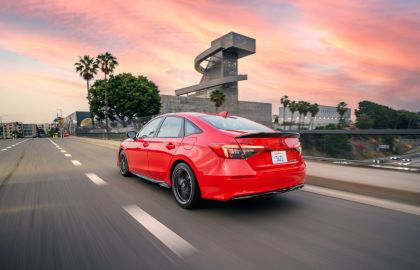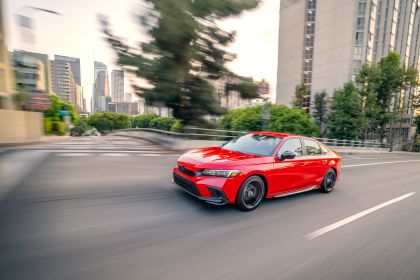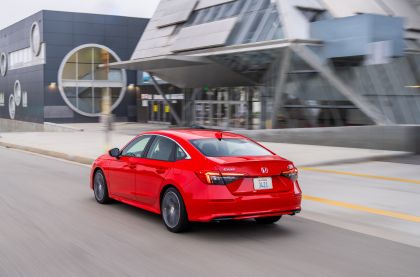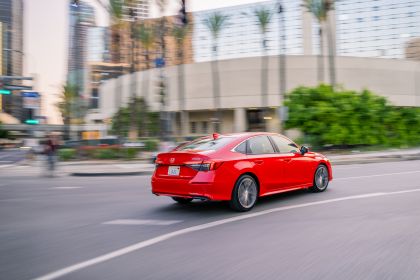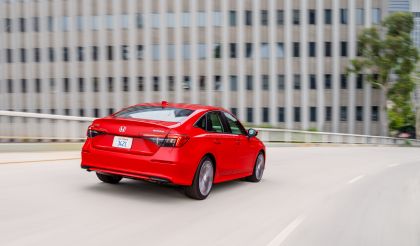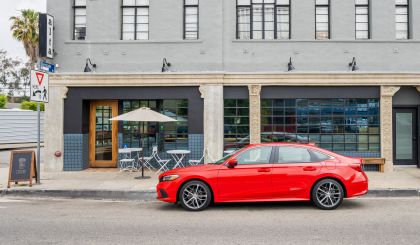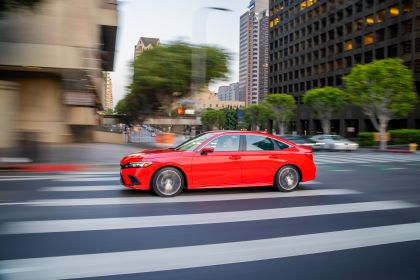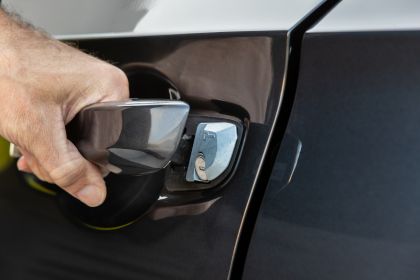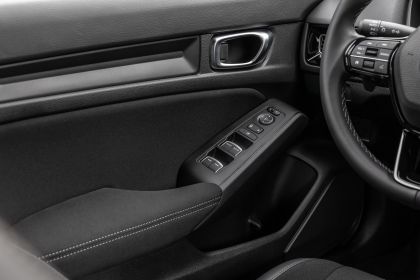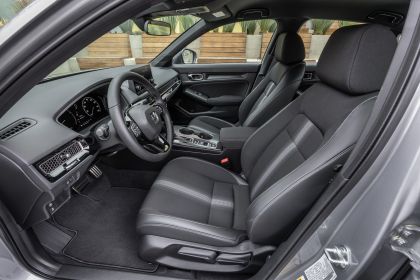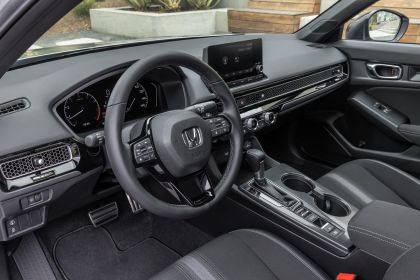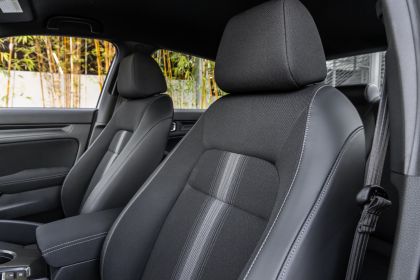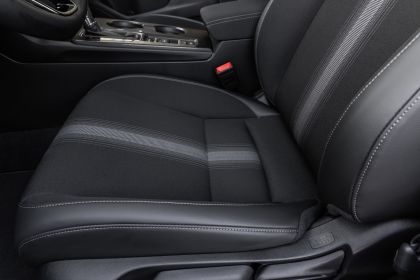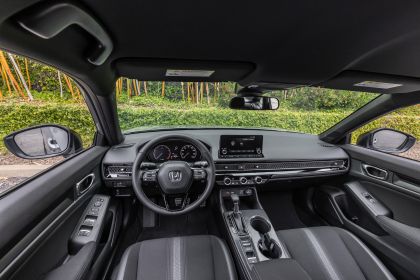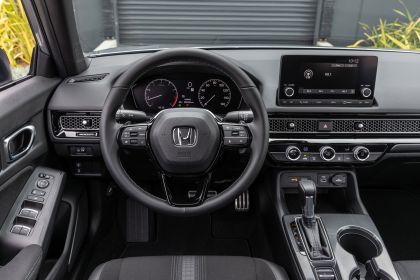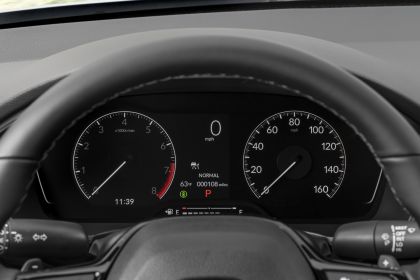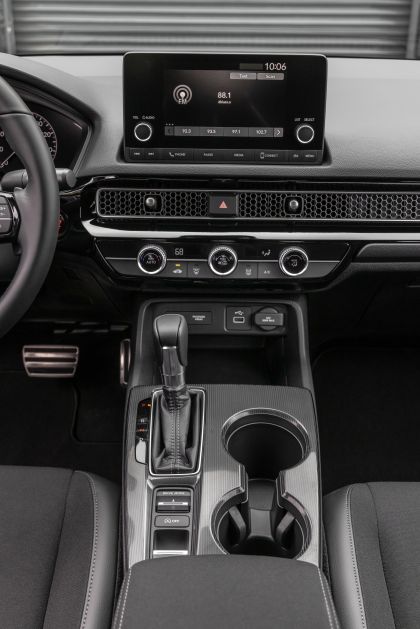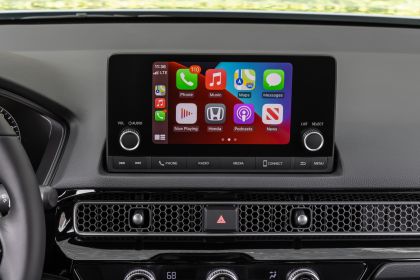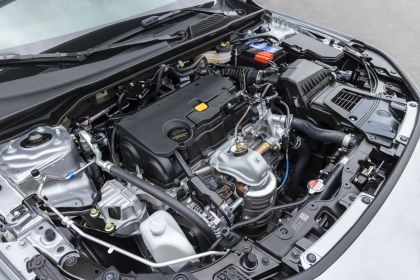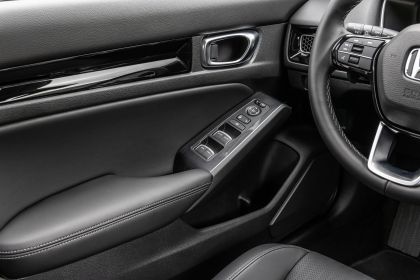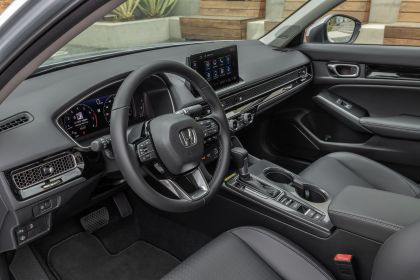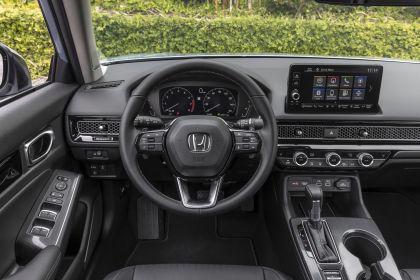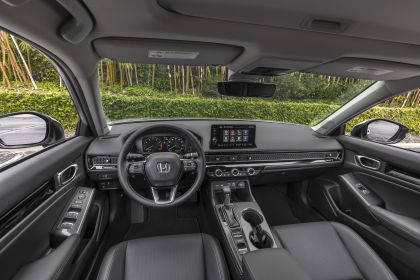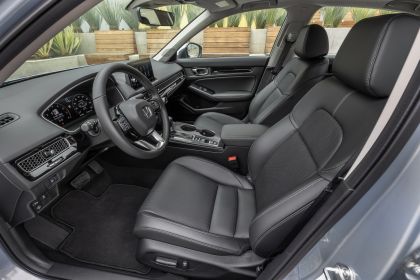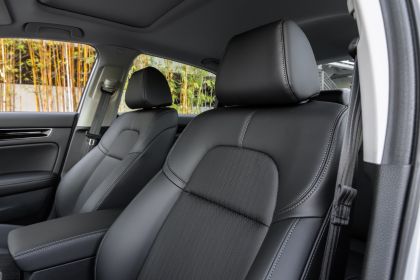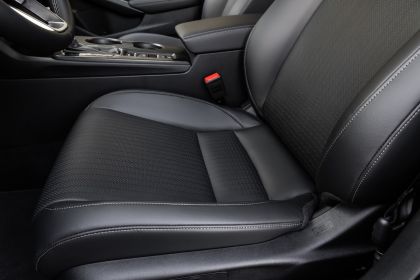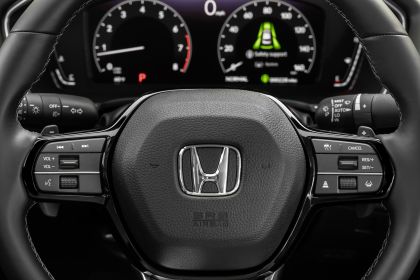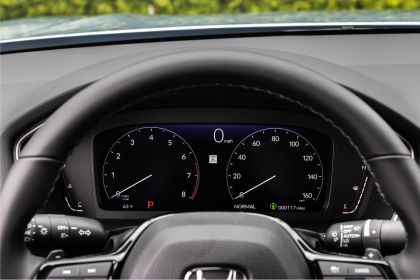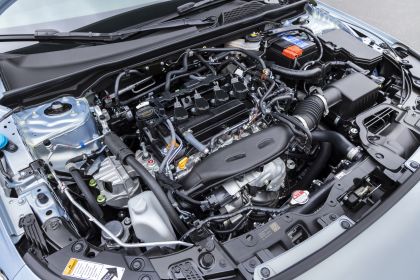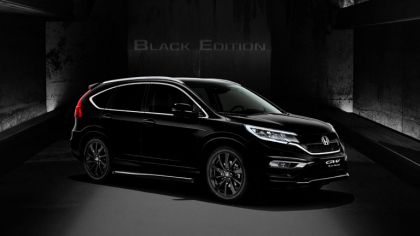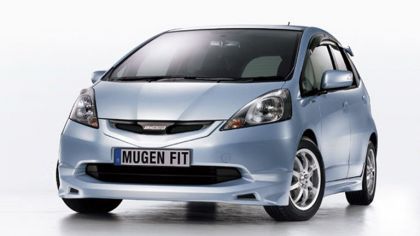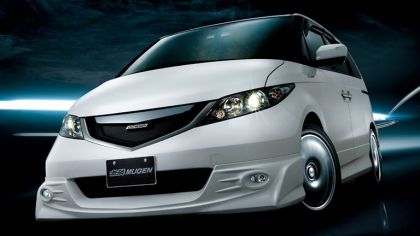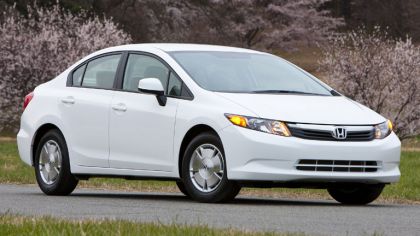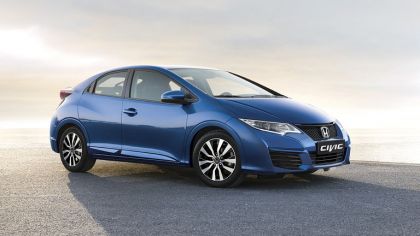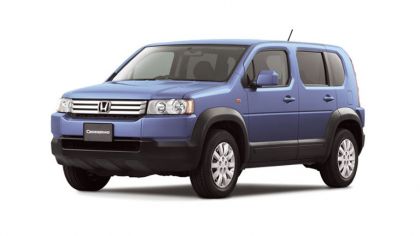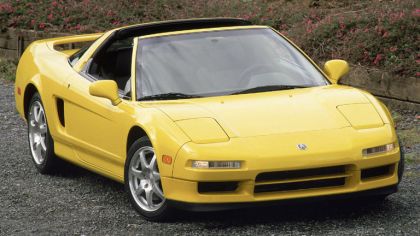- Inside and out, all-new Civic is a modern expression of Honda's human-centered design philosophy
- 2022 Civic Sedan readied for mass production at Honda plant in Canada
- Popular Civic Tour returns for 20th anniversary of the concert series
- More information, specs and assets coming April 28
Honda offered the first official exterior look at the production 2022 Civic Sedan today as preparations for the start of mass production near completion at Honda of Canada Mfg. in Alliston, Canada. Previewed last November with th Civic Prototype, the 2022 Civic Sedan is the most fun to drive and technologically advanced sedan in the model's nearly 50-year history.
Inspired by the timeless design and human-focused values of past Civics, designers and engineers prioritized Honda's human-centered design philosophy, which maximizes the total environment for the driver and passengers, while minimizing the space needed for mechanical components. The goal is to increase the driver's ability to enjoy the car safely. The result is a sporty new look and an all-new simple and sporty interior that advances essential Civic values of uncluttered design, simple ergonomics and exceptional visibility.
As Honda gears up for Civic's arrival in dealerships this summer, the Honda Civic Tour returns on April 28. For its 20th anniversary, Civic Tour is going virtual this year, with two tour stops. The April 28 headline event will be live streamed on the Live Nation Channel on Twitch and the second stop will be live streamed on the Honda Stage YouTube channel this summer. Starting at 5:00 p.m. PT, the April 28 virtual concert event on Twitch will also give Civic Tour fans a special first look at the all-new 2022 Honda Civic Sedan around 6:00 p.m. PT, leading into the performance.
As previously announced, the all-new Civic Hatchback will follow Civic Sedan production by several months. Details about Civic Hatchback, to be manufactured by Honda in the United States for the first time in its history, will follow later this year. The Civic Hatchback will be built at the company's Indiana auto plant.
More information about the all-new Civic Sedan, including photography, video and specifications, will be released on April 28.
----------------------------------------------------------------------------------------------------------------------------
The all-new 11th-generation Honda Civic Sedan has been reimagined for a new generation of drivers, with a clean and modern interpretation of Honda's longstanding "Man Maximum/Machine Minimum" design philosophy. In essence, the M/M philosophy means maximizing the total environment for the driver and passengers, while minimizing the space needed for mechanical components.
As a result, the Civic features sporty design with a low cowl, excellent visibility, exceptional attention to detail and a space-efficient, human-centered interior. With two improved powertrains and a stiffer body structure graced by a reengineered chassis, the 11th-generation Civic also upholds the Civic tradition of rewarding its drivers with class-leading driving dynamics.
Plus, a new version of the Honda Sensing® suite of active safety and driver assistive technologies and multiple new airbag designs - including a world's first application - continue to advance the state of the art in small-vehicle safety.
- 11th generation Civic raises the bar in every conceivable way - design, performance, fuel economy ratings, safety features and technology
- A modern interpretation of timeless Civic design values
- Sporty style with a longer hood and expanded dash-to-axle ratio for a premium profile
- All-new simple, clean, and uncluttered interior with an intense focus on the user experience
- Civic first all-digital LCD instrument display, and a new full HD 9-inch color touchscreen, the largest in a Honda brand vehicle (available in Touring)
- Improved powertrains offer new levels of performance, fuel efficiency and refinement
- Updated chassis, suspension and high-rigidity body combine for fun-to-drive dynamics with a comfortable ride
- Civic Sedan will be followed by the Hatchback, the high-performance Si, and the pinnacle of Honda performance - the Civic Type R
Civic Development
The new Civic builds upon nearly 50 years of heritage as Honda's longest-running automotive nameplate and its largest selling model globally. Lauded as a "breath of fresh air" by a motor journalist in 1972 at the introduction of the first-generation Civic in Japan, Civic was similarly praised upon its introduction in the U.S. in 1973. Civic was heralded for its fun-to-drive dynamics, quality construction and world-class fuel efficiency, qualities that have defined every generation since. Civic also earned a reputation for engineering excellence, starting with the revolutionary CVCC (Compound Vortex Controlled Combustion) engine that debuted in Civic and cemented Honda's place in history as a leader in powertrain innovation and reduced tailpipe emissions that met regulations under the U.S. Clean Air Act without use of a catalytic converter.
With every subsequent generation, Civic has become an influential part of the automotive landscape as well as a common sight on roads around the country. As it has evolved over the years, Civic continued to deliver a "wow" factor to people all around the world, from the innovative and classically styled third-generation Civic Hatchback with its innovative "long-roof" design, to the fifth-generation Civic which became the new benchmark for its class, and ushered in a new generation of hot-rodders with its sporty design and use of exotic VTEC® variable valve timing and lift. With the eighth-generation, Civic matured and grew in size and features as the needs of entry-level buyers changed.
The outgoing 10th-generation Civic in particular set a new high-water mark for style, driving dynamics, and sophistication that led to it being the most popular Civic ever in the U.S., with sales of more than 1.7 million units over the last five years. The 10th-generation Civic also has been the No. 1 model in America, car or light truck, with first-time buyers, Millennials, Gen Z and multicultural customers since its launch in 2015. And since 1973, Civic is the 4th best-selling car in America.
Simple and Sporty Exterior Design
The new 11th generation Honda Civic Sedan draws inspiration from earlier Civics, while taking a fresh take on Honda's human-centered approach inside and out. The simple and sporty exterior styling features a low beltline with a long and low hood, pulled back A-pillars, and ample glass area. The wide-set LED headlights and taillights are connected with a sharp character line that carries from the front fender to the taillights, while the horizontal orientation of the taillights give Civic a sense of stability on the road.
Human-Centered Interior and Technology
The Civic's simple and clean interior design themes are an equally modern take on classic Civic design cues, such as the low cowl and an expansive outward view. The instrument panel and other interior surfaces have all been designed with a minimum number of cut lines to reduce visual distractions. High-quality materials abound, especially on physical touch points, and extraordinary attention to detail was paid to the feel and operation of all switchgear and controls.
A visual focal point is a striking metal honeycomb mesh accent that stretches across the dash from door to door. More than just appealing to the eye, the mesh also serves as a visual dividing line between information above and controls below while also cleverly hiding the air vents. The Civic's front seats have been redesigned for maximum support and long-haul comfort, helping to turn even the most torturous commute into something drivers look forward to.
Technology is focused on intuitive ease of use, from the first all-digital LCD instrument panel ever in a Honda (Touring trim), to new color touchscreen audio systems mounted high on the dash. All Civic trims come standard with Apple CarPlay® and Android Auto™ integration, and wireless connectivity is available. For the first time, Bose premium sound will be available in Civic and has been custom engineered precisely for the Civic's new interior.
Fun to Drive
The 10th-generation Civic cemented Civic's reputation for delivering driver satisfaction, and the 11th-generation Civic builds upon that foundation. The new Civic's more rigid body structure provides an improved basis for dynamic excellence. Tuned on European roads, the chassis has been updated for improved handling and sharper steering by careful refinement of the components to create a refined and fun driving experience, while still delivering a comfortable ride.
Under the hood is a choice of two updated in-line four-cylinder engines: a naturally aspirated 2.0-liter (LX and Sport) or a turbocharged 1.5-liter (EX and Touring). Both are paired with an updated continuously variable automatic transmission (CVT) uniquely tuned for each engine. Both drivetrains have been reengineered for improved power delivery, refinement, fuel efficiency, and engine sound, with a more natural responsiveness thanks to improved G-Design programming, and the addition of Honda's "Step-Shift" programming that simulates gear changes when accelerating.
Advanced Safety
Civic has earned a reputation as a leader in small-car safety performance, and the 11th-generation continues that tradition with multiple new active and passive safety systems. In a world's first, both frontal airbags have been designed to reduce the likelihood of brain injury by better controlling head motions in a collision, especially in oblique impacts, by reducing the rotational head motion of the driver and passenger. Additionally, the Advanced Compatibility Engineering™ (ACE™) body structure has been reengineered for even better compatibility in collisions with larger vehicles, and for enhanced occupant protection in oblique collisions.
The Honda Sensing® suite of active safety and driver assistive technologies goes to the next level with the 11th-generation Civic. Using a new single-camera system that provides a wider field of view than the previous radar-and-camera based system, the new Honda Sensing® also uses a faster processor to more quickly identify pedestrians, bicyclists and other vehicles, plus road signs and road lines. Expanded functionality includes new Traffic Jam Assist, and improvements such as more natural brake feel and quicker reactions when using Adaptive Cruise Control (ACC), and more natural steering feel when using the Lane Keeping Assist System (LKAS).
Continuing 35 Years of North American Manufacturing
Civic has been built in North America for 35 years with nearly 11 million Civics produced in North America, with almost half of those made at Honda plants in the United States, using domestic and globally-sourced parts. The 11th-generation will continue that legacy with production of the Honda Civic Sedan being built in Alliston, Ontario, Canada and, for the first time, the Civic Hatchback will be manufactured in the U.S., at the company's Greensburg, Indiana auto plant.
Exterior Design, Package, Body
Developing the exterior of the 11th-generation Civic was a coordinated effort between the exterior and interior design teams. In particular, the team took inspiration from the overall philosophy that guided the styling of the third-generation Civic (1983-1987), with its expansive-feeling cabin with lots of glass area, supported by a body with a low hood and beltline.
Planning for the new car began by studying how vehicle proportions such as the ratio of vehicle height to tire diameter have changed over time on a variety of vehicles, including Civic and Accord. Based on those studies and the advanced materials, platform design, and collision safety technologies available today, the discussion turned to further refining the traditional Civic configuration of a cabin with lots of glass area atop a thin, light, and sporty body. That included how the car would look on the road, particularly from the rear, and the designers went to great lengths to give the new Civic a wide stance with horizontal and broad-set taillights, emphasizing its low center of gravity and communicating its driving performance.
The result of these efforts is a refreshing, exhilarating and approachable exterior design with a large, glassy cabin that delivers a feeling of space and an expansive outward view. The wedge shape of the 10th-generation Civic is traded for a new, more linear and horizontally oriented shape that continues from the front fenders all the way to the taillights. To emphasize Civic's ground-hugging stance the horizontal theme is continued up front and in the rear, while the overall design accentuates the size of the wheels and tires to create an immediate impression of stability and driving performance.
Exterior Design Details
Key to achieving the upscale styling goals of the 11th-generation Civic was pulling the bottom of the windshield A-pillars rearward by 1.96 inches. This elongates the hood, giving Civic a premium silhouette, and visually connects the pillar to the front wheel hub. This subtle design change creates a visual connection between the tires and the pillar creating a sense of stability.
Additionally, the outside mirrors are now mounted on the door, behind the A-pillars, rather than at the base of the pillar itself. This helps reduce visual clutter and improve outward visibility for the driver and passengers. Along the roof line, Civic uses a laser brazing technology first applied to Accord, but with even tighter tolerances, eliminating the need for roof molding for a smooth and clean roof line.
The hood has been lowered an inch where it meets the pillars, creating a "thin" profile by lowering the fender line which helps make the tires appear larger. The character-line that runs the length of the car from the front fenders, under the windows, to the taillights emphasizes the low glass sill and the expanded glass area. This lowered window sill is especially apparent on the rear doors, where the trailing edge of the window has been lowered by 1.2 inches directly above the hip point of the rear seat, creating an airy feeling for rear seat occupants and further accentuating the horizontally-oriented styling.
The door handles are in a straight line under the character line, and the handles themselves have been redesigned for a cleaner look. A touchpad has replaced the locking button seen on the 10th-generation, and the keyhole has been cleverly hidden behind the handle itself. The strong horizontal lines also serve to emphasize the additional 1.4 inches of wheelbase. Complementing the horizontal motif is an upswept lower character line that begins right behind the front wheel, sweeping gradually upward toward the rear, and ultimately tying into the rear bumper.
The face of the new Civic is youthful and clean, with a horizontal style set off by wide-set headlights and a grille with horizontal bars. The length of the hood visually pushes the upper grille forward, and the low-and-wide impression is highlighted by placing the upper grille slightly lower than the headlights. A large under-bumper grille gives Civic a subtly aggressive look.
In the rear, the 11th-generation Civic benefits from a 0.5-inch wider track while maintaining the same overall width as the 10th-generation car. This is achieved by pushing the rear wheels as close to the edge of the body work as possible thanks to newly hemmed wheel arches. This allows the wheels to be situated nearly flush with the fender without fear of tires interfering with the body work when the suspension is compressed.
This results in a strong shoulder at the rear, and the Civic's low center of gravity is further emphasized by connecting the rear fenders smoothly to the thin, compact, wide-set LED taillights. The additional stability provided by its new wider rear track is further emphasized by the upswept and aerodynamically beneficial trailing edge of the trunk lid.
Lighting Design
LED lighting is used extensively for the exterior, including the wide-set headlights, daytime running lights, parking lights, and available fog lights. Serving more than just a functional role, lighting is an integral part of Civic's design. For example, the momentum of the character line which runs from the front all the way to the rear is also reflected on the front and rear lights. This applies with the lights on or off and creates a feeling of linearity with the entire body.
In front, the three-lamp headlight unit places the high beam in the middle, creating a "pupil" effect when the high beams are off. Functionally, the headlights have been designed for improved illumination, with one of the low-beam units having better lateral illumination, and the other distributing light farther and wider down the road for improved visibility at night, all of which target a TOP SAFETY PICK+ rating from the Insurance Institute for Highway Safety (IIHS).
The taillights were designed to enhance the uninterrupted flow of the side character line and thus blend with the upper character line. Additionally, when turned on the internal lighting of the taillight maintains that character line. The taillight also uses a new fine-cut inner lens that ensures the lamp shines evenly from all angles. A conventional inner lens uses light-diffusing cuts that are more than 1.0 mm wide, and between 1.0 and 0.2-mm deep. The technology used in Civic is achieved by fine machining the width between 0.2 and 0.5 mm, with a depth as small as 5 to 25 microns (0.005 to 0.025 mm). This gives the lamp an even shine when turned on, and a clean look with almost no noticeable cutlines when off.
Four New Wheel Designs
Four unique wheel designs will be available for the new Honda Civic sedan, ranging from 16-inches to 18-inches, and all with variations of a split-5-spoke design. Civic LX uses a V-shape motif with wheel trim cover painted Blade Silver and Berlina Black. The 17-inch wheels on the EX trim are machined and finished to help reduce aerodynamic drag, and the machined faces are offset by spoke sides painted Berlina Black for added depth.
Civic Sport wears 18-inch Berlina Black wheels with a classic structure that's immediately associated with performance, and a strong sense of depth achieved through pushing in the center of the wheel and bringing out machine-cut surfaces. The 18-inch wheel worn by Civics with the Touring trim features a sophisticated look, with additional thin spokes combined with thicker machine-cut spokes.
Enhanced Structure and Stronger Body
Underpinning the 11th-generation Civic is an enhanced structure and stronger body, with multiple improvements to the platform and body yielding increased stiffness and rigidity that benefit Civic's ride, handling, and crash performance. This includes circular frames around the engine compartment bulkhead and behind the rear seats. Stiffening these sections results in a better balance of front-rear rigidity, which helps improve steering feel and accuracy at all speeds.
Floor strength also is improved via lattice frame members and by joining the front and rear ends of the center tunnel to the dashboard lower and rear crossmember. Overall, the new Civic is 8-percent stiffer in torsional rigidity, and 13-percent stiffer in bending rigidity compared to the 10th-generation.
While increasing structural strength can mean an increase in weight, several new construction techniques were used in the new Civic to minimize weight gain. Weight reduction measures include the use of an aluminum hood-a first for Honda Civic sedan in North America.
Application of Structural Adhesive Application
To achieve a radical reduction in cabin noise, vibration and harshness, the 11th-generation Civic uses 10 times more structural adhesive than the 10th-generation car. Applying the adhesives where spot welds are performed combines the strength of the weld and the broader surface area of the adhesive. This increases the stiffness of the joint, minimizing the need for increased sheet metal thickness or the addition of welded-on reinforcements.
Aerodynamic Performance
The 11th-generation Civic sedan possesses outstanding aerodynamics thanks to careful tuning of the design. This was crucial to achieving high targets for fuel economy ratings and road noise reduction. In front, a new and better bumper corner shape was used, which lets the air flow smoothly from the side of the front bumper to the side of the wheel, reducing the side wake.
Additionally, airflow separation over the front pillar was reduced by increasing the area of drip molding, and airflow turbulence under the door mirror was reduced by adding small vortex generators to the underside of the door mirror housing. The 17-inch aluminum alloy wheels on EX trim were designed for a low CD value by optimizing the area of opening and surface angles.
In the rear, the height of the trailing edge of the trunk lid is optimized to reduce downwash. In addition, the taillights were designed to reduce the trailing vortex behind the vehicle.
Exterior Colors
The 2022 Honda Civic sedan will be available in eight colors. From the 10th-generation Civic color palette comes Rallye Red, Aegean Blue Metallic, Platinum White Pearl, Lunar Silver Metallic, Crystal Black Pearl and Sonic Gray Pearl, available for the first time on Civic Sedan.
Two all-new colors also are available: Meteorite Gray Metallic, which replaces Modern Steel Metallic, and Morning Mist Blue Metallic-a very light blue color with a sense of translucence and soft gold highlights.
Interior Design and Package
The 11th-generation Civic interior introduces a new design direction for future Honda models with an intense focus on the classic M/M design values and a human-centered approach that uses technology and design to serve the needs of the driver and passengers.
Creating the new interior, and by extension a new interior design language for Honda, required a new way of thinking about a car's interior, and a new approach for design. The team settled on the concept of a "fine morning" as the theme for their direction, with the goal of designing a comfortable cabin that contributes to the creation of a feeling of freedom and vitality, turning every drive into a positive experience drivers would look forward to.
To help accomplish this, the designers spent two weeks in the U.S. verifying first-hand the kinds of experiences that went into having a "fine morning," not just behind the wheel, but as an everyday experience. The team was reminded of how small things matter, such as the expansive feeling of morning light shining through doors and windows. The challenge of translating that kind of productive and meaningful time to when driving to work, with the stress of traffic congestion, was no small task and required new methods of interior design development.
In the early stages of development, the team built a test vehicle by modifying the hood and pillar positions of the 10th-generaton Civic. By driving, modifying, and maturing this test vehicle, they were able to refine their concept to determine the framework for the goal of a "fine morning," translating many of their thoughts and methods into the final production model. The design team also broke convention by working with the Color, Material and Fabric team to develop knobs, switches, and other physical touch points before the overall design motif had been settled. This focus emphasized at a high level how visual and tactile interior qualities affect the entire experience.
The resulting interior is a clean and simple user-friendly space that enables the user to easily obtain information from outside the vehicle through the large glass areas while driving, and feel refreshed and satisfied when the vehicle is at rest. The user-friendliness is grounded in the concept of "function flow," developed using the understanding that making in-vehicle tasks as simple as possible leads to driver satisfaction. The form and function of switches and other fixtures were carefully designed to be most suitable for each task, be it a twist, push or pull, with special attention to the click feel and amount of spring force in controls. Careful attention to detail included consistency between surface treatments, even on decorative parts, with the goal of creating an environment comparable to high-end tech devices.
Ergonomically, the interior was developed along two core ideas. First is "instantaneous recognition," which means communicating accurate information in the shortest amount of time. The other is "intuitive operation," which means the user must be able to use features naturally. To this end, the new Civic places meters and the center display on the upper part of the instrument panel, allowing the driver to gain useful driving information with limited eye movement. Since controls for the climate system and side windows are out of the driver's line of sight, they were positioned along the lines of the driver's natural functional flow, allowing intuitive operation with minimal movement.
Improved Visibility
Civic's classic design values pay dividends inside. The feeling of spaciousness is immediately felt and shared by all Civic occupants thanks to the low, flat beltline and uncluttered cabin design. The pulled-back A-pillars, low hood, flat dashboard and hidden windshield wipers result in a windshield with clearly defined corners for a panoramic view, offering a horizontal angle of the view that is increased to 87 degrees compared to 84 degrees for the previous Civic. Furthermore, the outside mirrors were mounted on the doors, rather than at the base of the A-pillar, creating a space and sightline between the front pillar and side view mirror for improved peripheral visibility.
In addition to featuring a square-shaped front glass, the flat instrumental panel was designed through CAD and clay models so that the joints and seams are positioned to reduce the visual noise from windshield reflections. Additionally, the low cowl is the same height as the door windowsills for an uninterrupted and harmonious flow that extends from the dash all the way to the rear doors.
Taken together, the enhanced visibility afforded by the exterior structure and interior design make it easier for the driver to understand the vehicle's position relative to its surroundings, whether traveling in a straight line or when cornering.
Interior Packaging
Honda's outstanding interior packaging results in ample head, leg, shoulder and hip room for all passengers, with volume increased by 1.2 cu.-ft. for a maximum total of 99.0 cu.-ft. (96.6 with moonroof) of passenger space. Beyond that, the new Civic increases the quality, comfort and user-friendliness of the interior space by making changes to the form and design.
In the rear, the extended wheelbase allowed for an increase in torso angle from 26 degrees to 27 degrees, which combined with the improved visibility makes for a more relaxed and less tiring rear seat, especially on long rides. The new Civic also retains the generous rear seat room of the previous generation car, adding more upper body freedom thanks to the lowered shoulder line.
The rear overhang was shortened by 1.4-inches (35 mm) compared to the previous-generation Civic, however cargo usability was improved by expanding the lower side of the trunk opening by 5.3 inches (134 mm) to make loading and unloading of baggage easier. The 14.8 cu.-ft. (14.4 in Touring) of trunk space easily accommodates four 9.5-inch golf bags, and the cargo area can be expanded by folding down the rear seatbacks for longer objects.
New Body Stabilizing Front Seats
All Civic trims benefit from new Body Stabilizing Seats for driver and front passenger. The new seat design uses multiple new internal structures to provide improved support across the entire body, enhancing comfort on long drives. This includes a new resin mat that supports the area from the pelvis to the lumbar spine for a more stable and solid seating feel.
An inner frame on the seat bottom stabilizes the hip to reduce movement and posture changes regardless of the various G forces the user may experience while driving. The curve of the seat bottom also leaves no gap between the seat and thighs to prevent sliding forward, which couples with the internal structure to reducing forward and lateral pelvic tilt that can lead to fatigue and discomfort on long drives. The seat also centers the upper body over the pelvis, helping to stabilize the upper arms and the eyesight of the driver, making it easier to drive.
From a design standpoint, fabric and leather upholstery use wrinkle-resistant materials with a virtually perfect finish all the way to the edges. The seatback also uses a single material, eliminating inconsistency in visual quality for a "clean" view from the rear seats, with a minimum of seams.
Honeycomb Mesh Instrument Panel Trim
The striking metal honeycomb mesh accent that stretches from door to door across the dash serves multiple functions. It creates a dramatic visual dividing line, cleanly separating the dash into an "information" section on the top with the instrument panel and touchscreen audio systems, and a "control" section on the bottom that includes climate and other physical controls.
In addition, its design is flow-through, concealing air vents that might otherwise mar the uncluttered look of the dash. Hiding the air vents in this way also is an extension of the "fine morning" concept of the interior, as air outlets can stand out particularly in the morning sunlight. The knobs operating the vents went through multiple design iterations to achieve a high-quality operation feel, with the final version reminiscent of high-end home entertainment devices.
Fine-Quality Trim and Materials
The early research conducted on the interior concept resulted in exceptional care taken throughout to use the highest quality materials and surface treatments. Controls and switchgear were all designed with a high tactile quality and simple design, with a metallic finish on components such as the climate control knobs conveying an upscale feel. The interior door handles use a platinum-look coating for a high-quality appearance and were designed to be easier to use. The center console features a new finish that evokes the high-quality appearance of piano black, but without the propensity for smudges, fingerprints and scratches that can affect that material over time. On Touring grades, the same material is used on the window switch panels.
Fit and finish also was given a high priority. This included details such as precisely fitting the tweeter into the A-pillar, since it comes into the field of view of the driver. The center B-pillar was designed with a ridge that actively picks up outside light, making it look thinner, and reducing the feeling of confinement for rear seat passengers. Even the cover for the new Honda Sensing® wide-view camera was designed to create a sense of unity with the upper console, achieving a clean look.
Center Console
The center console was designed with a focus on ergonomics to help drivers perform tasks easily and without distraction, while trim and colors were carefully chosen to give the console a class-above appearance.
The shift knob has been tilted toward the driver by 5 degrees, allowing the cup holders to be positioned to the right of the shift knob and still hold large-size cups. Smaller tubs built inside the holder allow it to stably hold smaller types of cups, such as the now-popular, skinnier insulated bottle. In front of the shift knob is a generous tray designed to accommodate large smartphones, doubling in the Touring trim as a wireless charging pad. The standard USB port in the front of the console is lit to make it easier to find at night.
Usability improvements include switches and other controls that are laid out along the driver's operational flow. For Sport and Touring trims, the drive mode switch is located directly above the button for the electric parking brake, making it easy for the driver to find without looking. In addition, the large center console storage bin uses a lid which automatically pops up to a 60-degree angle (manually to 90 degrees), making it easier for shorter drivers to open and close the lid without twisting their body.
The console trim has a clear, gloss resin finish. However, to prevent the fingerprints and scratches that can mar the surface of piano black surfaces over time, the die for the console trim was machined in a very fine pattern. This pattern produces very fine lines which hide scratches much better, while creating an attractive visual accent for the cabin space. On Touring trims, the pattern is also used on the window-switch panels.
Reducing Cabin Noise
Cabin noise can be attributed to multiple sources, and engineers took a multi-pronged approach throughout the new Civic to address noise and vibration at the source and reduce the transmission of residual noise and vibration to the cabin itself.
This includes the first use of urethane spray foam for Civic, radically reducing cabin noise. The urethane spray foam is used in 10 places and is particularly effective in the hollow portions of the body structure, including the front and rear end of the side sills, and the starting and ending points of each pillar.
Engine vibrations were reduced by various measures, such as an improved torque rod to control longitudinal vibrations, additional fastening points of the engine side mount stay, and increasing the rigidity of both the crankshaft and oil pan on 1.5-liter turbocharged engines. Under-hood components that can transmit vibrations, such as the air cleaner and intercooler, were designed with an eye to reducing noise and vibration wherever possible. Additionally, revised programming for the engine and CVT provide a more linear and natural-sounding relationship between engine and vehicle speeds.
Likewise, road noise is first mitigated at the source with multiple measures taken to reduce the vibrations that can cause noise. This included improving overall body rigidity as well as increasing the rigidity of the underbody panel. Additional measures were taken throughout the chassis to reduce the transmission of road noise through the suspension, including improved bushings in the rear multi-link suspension.
Sound insulation is used in multiple places throughout Civic to prevent remaining noise from the engine compartment, road, suspension, and even body panels from penetrating the cabin. This includes sound insulation on the underside of the hood, the engine under cover, and the dashboard panel, plus a dashboard inner insulator and noise-absorbing instrument panel insulator to reduce the transmission of engine sounds to the cabin.
Road noise also is reduced through the use of a noise-absorbing floor undercover and rear inner fender liner, plus noise-absorbing carpeting. To reduce noise coming from the rear of the vehicle, noise insulators are installed on the trunk side of the rear wheel well.
HMI and Technology
The human-centered design of the 11th-generation Civic includes the use of technology to benefit the driver and the result is the most technologically sophisticated Civic ever. Advanced features include digital instrumentation for all trims, with the Civic Touring grade featuring the first all-digital LCD instrument cluster ever in a Honda vehicle in the U.S. Two new touchscreen audio systems are available: A standard 7-inch color touchscreen, and a new 9-inch version of the HD color touchscreen used in Accord and other Honda vehicles is standard on the Touring trim. Both audio systems are placed nearly 4 inches higher on the dash for better visibility and ease of use.
Both audio systems are designed with an eye toward simplicity of operation with additional hard buttons, including a volume knob, and a simplified menu structure. For the first time in Civic, Bose® audio with Centerpoint 2 technology is available, and a new navigation system seamlessly integrates the in-vehicle navigation with the owner's smartphone for expanded functionality.
Digital Instrumentation
All 11th-generation Civic trims use digital instrumentation. LX, Sport and EX grades are equipped with a 7-inch color TFT display. The right side of the instrumentation is occupied by a physical speedometer. On the left side of the instrumentation is the TFT, which features depiction of an analog tachometer on its leftmost side. In between the tachometer and the speedometer, the TFT features a Multi Information zone that can present a range of alerts and information. A portion within the tachometer also can be toggled through a range of informational screens to present trip computer, audio, phone, navigation, driver attention monitor, traffic sign recognition and safety support.
Touring grades get Civic's first all-digital LCD instrument display. Measuring 10.2 inches, the high-definition full-color LCD panel displays a variety of information, all customizable from the steering wheel. Information can be displayed with traditional round gauges for the tachometer and speedometer, or with bar graphs flanking the left and right of the screen. A new mode available when using Adaptive Cruise Control eliminates the tachometer and speedometer from the display altogether (but maintaining a numerical speed readout) for a more relaxed driving environment.
In addition to the gauges, the LCD screen is used to convey information to the driver with customizable areas on the left and right side of the display. The left side of the screen is dedicated to audio and telephone information, which the driver can select using the left-side steering wheel controls. The right side is dedicated to driving-related information such as activating or deactivating various Honda Sensing® functions, or navigation system information, which the driver selects using the right-side steering wheel controls.
Between the speedometer and tachometer is an area dedicated to vehicle function, including Honda Sensing® status and a numerical speed readout. This graphic meter is used to communicate Honda Sensing® operating status in an easy-to-understand manner. The car itself is represented in a bird's eye view from behind, and the digital meter displays an accurate view of the surroundings, including indicating curves in the road, to match the actual road environment. The display also uses a motorcycle and box truck as options to express "other vehicles" ahead. In a fun surprise-and-delight feature, the brake lights, headlights and turn signals of the Civic icon turn on and off with those functions.
New Standard Audio
LX, Sport and EX grades come standard with a new audio system with a 7-inch color touchscreen, the largest standard screen in Civic history. Functionality is improved by a new physical power/volume knob on the left side, as well as a tuning/selection knob on the right side.
At the bottom is a row of hard buttons for many functions including skipping music tracks, navigating the audio menu and selecting between phone, radio, Bluetooth® or USB media. Apple CarPlay® and Android Auto™ integration are standard. On LX trims, the audio system powers four speakers, while Sport and EX have eight speakers, with tweeters added to the A-pillars and rear doors.
The physical buttons on the audio system are large and easy to use, and the system uses a fast processor for quick response with virtually no lag after inputs. To make it easier to use the switches and touchscreen when the vehicle is in motion, the screen is recessed slightly from the edge of the dash, resulting in a 0.8-inch finger rest that allows the user to steady their hand while making selections.
Larger Optional Audio Display
Civic Touring grade debuts an all-new HD 9-inch color touchscreen audio system, the biggest ever in any Honda vehicle. The system features a volume knob, physical buttons for Home and Back functions, large and easy-to-recognize icons, a fast processor for lag-free performance, and a simplified navigation structure with fewer embedded menus, resulting in a reduction of the time it takes to perform a task of up to 83 percent.
The 9-inch system also comes standard with wireless Apple CarPlay® and Android Auto™ integration, along with Qi-compatible wireless charging. Like the standard system, the 9-inch audio features a finger rest to make it easy to use the touchscreen while the vehicle is in motion. The 9-inch system also includes four 2.5A USB ports, with two in the front and two at the rear of the center console for easy reach by rear seat passengers.
The new 9-inch system is designed with simplicity in mind. User defined shortcuts are at the bottom of the screen, with Civic offering six easily programmable shortcuts. Making phone calls with a Bluetooth® connected phone is simplified with a reduced number of layers and simplified screen layout.
Also new are Smart Shortcuts, an automatic assistant function that enables the user to execute frequently used actions quicker and with fewer steps. The system uses machine learning to predict and propose user preferences based on the track record of the user's actions and behaviors. By pressing the icon on the home screen, the system displays frequently used commands, such as the "home" address, frequently visited places, a list of favorite radio programs, redials for received calls, or calling a person on the "favorite" list. For example, with one action, the system can call up the names of people the user calls frequently, eliminating the need to look them up in a directory. These shortcuts are stored on the Smart Shortcut menu, and a unique profile is created for each respective user.
Bose Premium Sound - A Civic First
Touring trims also feature a Bose premium sound system, the first use of a branded audio system in Civic. Featuring Bose Centerpoint 2 and Bose SurroundStage digital signal processing, the new system was custom-engineered precisely for the Civic's new interior so that drivers and passengers - regardless of their seating position - are placed in the middle of the music, with a clear and spacious listening experience for all audio content.
Expert audio engineers developed the Bose sound system with advanced components and technologies, working closely with Honda to integrate the system early in the vehicle design process for optimal performance. Clear, impactful sound is delivered through high-performance Bose speakers, strategically placed throughout the Civic's interior for exceptional music reproduction across all frequencies, low to high.
Helping to preserve the quality of the listening experience, Dynamic Speed Compensation technology automatically adjusts volume and tone based on vehicle speed, reducing the need for drivers to manually adjust settings while on the road.
Bose System Details:
- One 3.25-inch (80 mm) Bose Twiddler mid/high-range speaker in the center of the instrument panel.
- Four 1-inch (25 mm) lightweight neodymium tweeters - one in each A-pillar and one in each rear door.
- Two 6.5-inch (165 mm) wide-range speakers - one in each front door.
- Two 5.25-inch (130 mm) wide-range speakers - one in each rear door.
- Two 3.25-inch (80 mm) Bose Twiddler mid/high-range speakers - one on each side of the rear deck.
- One 8-inch (200 mm) subwoofer in the center of the rear deck.
Bose digital amplifier with 12 channels of custom equalization and advanced digital signal processing.
New On-Board Navigation with Smartphone Integration
The navigation system used on Touring grades of the 11th-generation Civic has been thoroughly redesigned, with an updated map system that's easier to read, simplified access to frequently used controls and smartphone integration.
The new system uses an improved 3D mode to clearly show objects such as buildings for easier navigation by landmarks. The display also uses more vibrant colors, and one-touch operation was added for frequently used functions such as route cancellation and muting navigation guidance. The system also can learn frequently used routes and using continuously updated traffic information from a user's smartphone, can suggest alternate routes even if navigation guidance isn't currently active. In addition, the new system will receive map updates four times a year, as opposed to once a year.
Powertrain
Already the class benchmark for its combination of fun-to-drive personality and excellent fuel economy ratings, the 11th-generation Civic takes it to the next level with changes to both available engines. The naturally aspirated 2.0-liter 4-cylinder to improve emissions and fuel economy performance, while the turbocharged 1.5-liter 4-cylinder engine also gets improved fuel efficiency and emissions performance, as well as additional horsepower and torque. In addition, the continuously variable transmission (CVT) for each engine have been retuned for more natural, "synchronized" response, as well as further improvements to fuel economy.
2.0-LITER IN-LINE 4-CYLINDER & CVT
In LX and Sport trims, the all-aluminum 2.0-liter 4-cylinder produces 158-horsepower (SAE net) and 138 lb.-ft. of torque (SAE net) and powers the front wheels through a Continuously Variable Transmission (CVT). While mechanically similar to the 10th-generation version, multiple changes were made to both the engine and the CVT to improve drivability, fuel efficiency and emissions.
Improved Emissions and Fuel Economy Ratings
Changes to the 2.0-liter engine primarily focus on emissions and fuel efficiency improvements. A new catalytic converter uses a minimum of rare metals, while helping to reduce emissions to the SULEV30 federal standard. In addition, an Idle Stop system was added for the first time, reducing fuel consumption when idling at a stop. Combined with the new CVT, the engine updates improve EPA estimated fuel economy ratings in LX grades to 31 city, 40 highway, and 35 combined, gains of 1 mpg city, and 2 mpg highway and combined scores.
Cylinder Block and Crankshaft
The Civic's 2.0-liter inline four has a lightweight die-cast aluminum block with a bedplate main-bearing design that creates a rigid assembly to help minimize noise and vibration. Cast-in iron cylinder liners provide long-lasting durability. Thin slits between each adjacent cylinder sleeve help improve engine cooling and knocking.
Each journal on the lightweight heat-forged steel crankshaft is micropolished to reduce internal friction and improve smoothness throughout the rpm range and help lower noise levels.
Pistons/Connecting Rods
Designed with "cavity-shaped" crowns, the 2.0-liter's pistons help maintain stable combustion and contribute to improved efficiency. To reduce weight, minimize vibration and increase operating efficiency, the lightweight pistons have a carefully optimized skirt design. Ion-plated piston rings help reduce friction for greater operating efficiency. Heavy-duty steel connecting rods with tapered small ends are heat-forged in one piece and then "crack separated" to create lighter and stronger rods with an optimally fitted bearing cap.
Cylinder Head and i-VTEC® Valvetrain
The Civic's 2.0-liter 4-cylinder engine has a lightweight DOHC cylinder head that is made of low-pressure cast aluminum alloy. With exhaust passages cast directly into the cylinder head, the need for a traditional separate exhaust manifold is eliminated and the catalytic converter mounts directly to the cylinder head.
A low-friction silent-chain drives dual overhead cams and four valves per cylinder. The cam drive is maintenance free throughout the life of the engine. To assist cooling and detonation resistance, the cylinder head has a cooling passage placed between each pair of exhaust valves.
The combustion chamber shape and valve angles are optimized to help boost fuel efficiency and power. The included valve angle is 35 degrees, to decrease the surface-to-volume ratio of the combustion chambers and help create a flat, compact combustion chamber that minimizes unburned hydrocarbon emissions. The combustion chamber shape creates a compression ratio of 10.8:1, yet the engine still operates on regular unleaded fuel.
The cylinder head features a high-tumble intake-port design. In combination with the combustion chamber and piston crown shape, the design's high level of airflow tumble helps create a homogenous fuel mixture for low fuel consumption and high airflow for high power output.
The Civic's 2.0-liter DOHC 16-valve i-VTEC® engine uses an advanced valve control system to combine high power output with high fuel efficiency and low emissions. The system combines dual VTC™ (Variable Timing Control™), which continuously adjusts the intake and exhaust camshaft phase, with Variable Valve Timing and Lift Electronic Control (VTEC®), which changes valve lift, timing and duration of the intake valve opening.
The "intelligent" portion of the system is its ability to continuously vary the timing of the intake and exhaust camshafts using variable valve timing control (VTC™). This helps increase power and provides a smoother idle (allowing idle speed to be reduced). The cam timing is varied based on input from sensors that monitor rpm, timing, throttle opening, cam position and exhaust air-fuel ratio. The result is increased fuel efficiency and lower emissions. Under certain conditions, the VTC™ can hold the intake valves open longer to allow a reverse airflow of intake air into the intake manifold.
Refined Continuously Variable Transmission
The 2.0-liter engine's Continuously Variable Transmission (CVT) has been refined in multiple ways to improve drivability, responsiveness and fuel efficiency. Drivability improvements are accomplished by updating the following controls: G-Design shift, downshift strategy, and Step-Shift.
In various situations from normal to sporty driving, the updated G-Design shift further improves the linearity of the driver's throttle input relative to the acceleration of the vehicle.
The downshift control adds engine braking when going downhill and is redesigned to improve engine response during spirited driving as well as increased engine braking in highway driving. When the driver presses the brake pedal while cornering or on the highway, the CVT will select an appropriate lower ratio, maintaining a higher engine speed. This creates stronger engine braking while improving the engine response when acceleration resumes. The higher engine speed continues until the driver resumes a cruise or neutral throttle condition.
The Step-Shift function is activated during full-throttle acceleration. The CVT is programmed to control engine speeds in "steps," similar to a traditional automatic transmission, giving drivers a familiar audible cue for a better sense of acceleration.
To improve fuel efficiency, the CVT for the 2.0-liter 4-cylinder was updated with a new, more robust electric hydraulic pump. In a conventional CVT, a mechanical oil pump is responsible for both the high hydraulic pressure used to sandwich the steel belt by moving the pulley plates, and low hydraulic pressure for lubrication of each component. For the updated CVT, a new large-size electric oil pump is used to supply high hydraulic pressure for transmission operation, reducing the demand of the mechanical pump, and therefore improving fuel efficiency. In addition, the secondary shaft now uses a ball bearing versus the tapered roller bearing.
1.5-LITER VTEC® TURBO IN-LINE 4-CYLINDER & CVT
On Civic EX and Touring trims, a turbocharged 1.5-liter 4-cylinder is used, producing 180 horsepower (SAE net) and 177 lb.-ft. of torque (SAE net) on 87 octane gasoline, up 6 hp and 15 lb.-ft. of torque from last model year. The improvements result from the use of a new high-efficiency turbocharger and new turbo piping with reduced pressure drop, and a new 4-2 exhaust port/manifold cast into the head. The changes to the turbo system also helped improve fuel economy ratings, assisted by the addition of VTEC® to the exhaust valves. To significantly reduce unpleasant vibrations in the 300-600 Hz range, the crankshaft and oil pan rigidity were both increased.
In addition to fuel economy rating and horsepower gains, the changes made to the 1.5-liter engine work in concert with updates to the CVT's responsiveness to reduce turbo lag and substantially improve engine response. The improvements can be felt especially when accelerating from a stop, resuming acceleration after being off-throttle, or in heavy traffic on a highway. In addition, the added torque combines with new engine and transmission tuning to help improve acceleration when merging or passing other vehicles on the highway, giving Civic a more natural and linear response to part-throttle inputs.
Updated Turbo System
For the 11th-generation Civic, the exhaust channeled to the turbocharger now enters the turbine wheel diagonally, rather than from the side as before, and the shape of the turbine wheel blades also was changed. This new flow path enables the turbocharger to generate pressure in a wider range and more efficiently.
Moreover, by reducing the curvature of the intake air entry to the compressor housing and the high-pressure side pipe which leads to charged intake air discharge, the pressure drop is reduced, which increases efficiency by approximately 5 percent in all areas, resulting in high responsiveness and high output.
New 4-2 Exhaust Port Cylinder Head
While the 10th-generation used a 4-1 exhaust port/manifold cast into the head, the new Civic features a 4-2 design which consolidates the exhaust from the number 1 and 4 cylinders into one pipe, and the number 2 and 3 cylinders in a separate pipe. This reduces exhaust pulse interference, improving intake and exhaust efficiency, especially at low engine speeds. Additionally, the position of the air-fuel ratio sensor was moved, resulting in improved low-engine speed responsiveness. The efficiency gains in the adoption of the 4-2 exhaust manifold also contributes to the improvement of fuel efficiency.
Improved Fuel Economy Ratings and Emissions
In addition to improving horsepower, multiple steps were taken to improve fuel economy ratings and emissions. The 1.5-liter engine now uses VTEC® on the exhaust side, improving exhaust efficiency and optimizing valve overlap, efforts that contribute to improved fuel efficiency. Finer machining of the camshaft journals and low-friction materials for cam timing chain-related parts have been implemented, and the Idle Stop system used on the 2.0-liter engine also is used here. For emissions, a new catalytic converter that minimizes the use of rare metals is used, helping Civic achieve SULEV30 emissions certification.
Cylinder Block and Crankshaft
The Civic's 1.5-liter inline four receives noise and vibration improvements via larger crankshaft pins that make the crankshaft stiffer overall. Each journal on the lightweight forged-steel crankshaft is micropolished to reduce internal friction. The engine uses a lightweight die-cast aluminum block with individual reinforced main bearing caps to minimize weight. Cast-in iron cylinder liners provide long-lasting durability.
Pistons and Connecting Rods
The 1.5-liter engine's pistons help maintain stable combustion and contribute to improved efficiency with "cavity-shaped" crowns. The lightweight pistons also have a carefully optimized skirt design to minimize reciprocating weight, which minimizes vibration and increases operating efficiency.
The pistons are cooled by oil jets directed at the underside of each piston crown. Ion-plated piston rings help reduce friction for greater operating efficiency. Lightweight, high-strength steel connecting rods are heat-forged in one piece and then "crack separated" to create a lighter and stronger rod with an optimally fitted bearing cap.
Cylinder Head and Valvetrain
The direct-injected Civic 4-cylinder turbocharged engine has a lightweight DOHC cylinder head that is made of pressure-cast aluminum alloy. With the exhaust manifold cast directly into the cylinder head, the need for a traditional separate manifold is eliminated.
A low-friction, silent-chain drives dual overhead cams and four valves per cylinder. The cam drive is maintenance free throughout the life of the engine. To help further reduce weight, thin-wall hollow camshafts are used.
To benefit fuel efficiency, emissions and power, the turbo engine utilizes sodium filled exhaust valves. A hollow chamber within the valve contains sodium that is cooled by the exhaust port cooling jacket. As the camber reaches close to the valve head, the sodium helps to cool the entire valve. As the valve is internally cooled it doesn't need the enriched fuel mixture that was generally used in turbo engines to help cool the exhaust valve. The resultant leaner mixture reduces emissions, increases fuel efficiency and helps increase power. To provide a high-tumble intake charge that further enhances combustion efficiency, both the intake port and piston crown have special designs.
In addition to the new exhaust-side VTEC®, the 1.5-liter turbo engine continues to feature Variable Timing Control™ (VTC™) that can vary the timing of both the intake and exhaust camshafts independently. With this system, cam timing can be optimized to suit the driving conditions. Under light loads, valve overlap can be increased to reduce pumping losses and improve fuel efficiency. When engine speed is low and engine load is large, such as during initial acceleration, the amount of overlap is increased to boost the scavenging effect, which improves torque and responsiveness. When engine speed is high and engine load also is high, such as during full-throttle acceleration, the amount of valve overlap is reduced to increase engine output by improving both intake and scavenging.
Updated Continuously Variable Transmission
The CVT in the Civic is well known for its smooth and efficient delivery of engine power to the drive wheels. However, further steps were taken for the 11th-generation Civic to help reduce the "rpm-led" feel when the acceleration feel comes after the increase in engine speed. This "rubber band effect" was reduced in the new Civic with increased engine torque and improved turbocharger response, which generate stronger acceleration at lower engine speeds, giving the engine a more natural feeling acceleration. Additionally, with the increased rigidity of the crankshaft and oil pan, the changes in engine sounds due to RPM changes are further reduced.
In addition, the CVT for the 1.5-liter turbo uses a larger torque converter to better handle the additional torque generated by the updated engine. The transmission also benefits from the same drivability improvements as the unit used with the 2.0-liter 4-cylinder, including updated G-Design shift control, downshift strategy and Step-Shift function.
Additionally, Sport and Touring trims come standard with steering wheel-mounted paddle shifters, allowing drivers to choose between individual pre-set "ratios" for a dynamic driving experience.
Drive Modes
In addition to the Normal and Eco driving modes, drivers of 2.0-liter Sport trims and 1.5-liter Touring trims of the 2022 Civics have a new user-selectable Sport mode.
- New SPORT Mode - The exclusive CVT shift map used in Sport mode is designed for a powerful feeling of torque and high acceleration responsiveness. When in Sport mode, the minimum engine speed is 2000 rpm (unless stopped or at low speeds), even when cruising, to ensure quick throttle response. In the Touring trim, the gauges also gain red accents while in Sport mode.
- ECON Mode - Designed for fuel efficient driving, ECON mode changes the pedal input/throttle opening ratio to maintain fuel efficiency, even if the driver operates the acceleration pedal relatively aggressively. Additionally, the air conditioning is set to a more efficient cycle, which further improves fuel-efficient driving.
- Normal Mode - Normal mode is set for a balance between fuel efficiency and driving performance.
Chassis
Already a class leader in ride, handling and steering performance, engineers have further improved Civic's ride and handling with multiple refinements to the existing suspension and steering.
The wheelbase has been extended 1.4-inches under the rear seat, and its rear track is 0.5-inch wider. Together, these changes contribute to improved straight-line driving and steering stability. Additionally, numerous small improvements were undertaken to reduce suspension and steering friction, along with the use of more compliant suspension bushings, yielding noticeable improvements in dynamics and refinement.
The relationship between steering torque and yaw rate has been optimized to improve steering feel. Line tracing through low and high-speed corners also is improved by creating a more linear response to steering inputs. Moreover, the new Civic feels more synchronized, with no delay in the way the vehicle responds to steering inputs during lane changes and cornering, giving every Civic a sporty and confident feel. Additionally, the reduced suspension friction and improved bushings help improve the ride by reducing harsh impact shock and noise, such as when going over railroad crossings. Harshness noise is reduced by 20 percent.
Front Suspension and Steering: Combatting Friction
Friction in suspension and steering systems is the enemy of precise handling and ride comfort, so measures were taken in the new Civic to reduce the amount of friction in both systems, with the goal of improving the quality and feel of the suspension movement and steering.
The lower ball joints on the front suspension are heat treated through a tempering process, reducing the surface pressure between the ball and resin ball seat, and thus reducing friction in the ball joints. Additional friction-reducing measures include the use of a low-friction seat for the front damper mount bearing and optimizing the axes of the spring and damper. A honing process is used on the steering column bearing, further reducing steering friction and improving the quality and feel the driver experiences when first turning the steering wheel.
An all-new aluminum front subframe with an efficien
